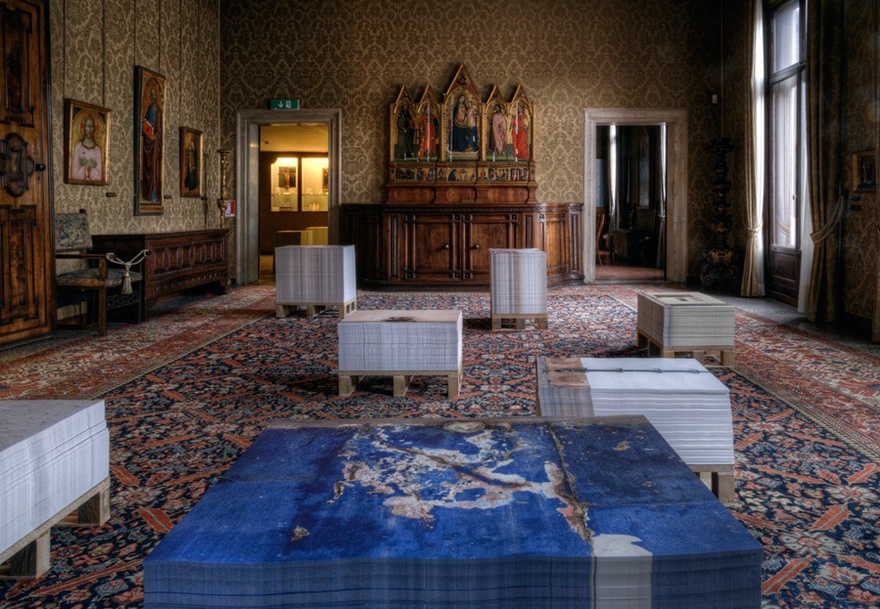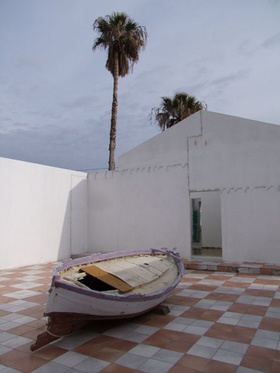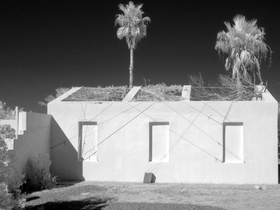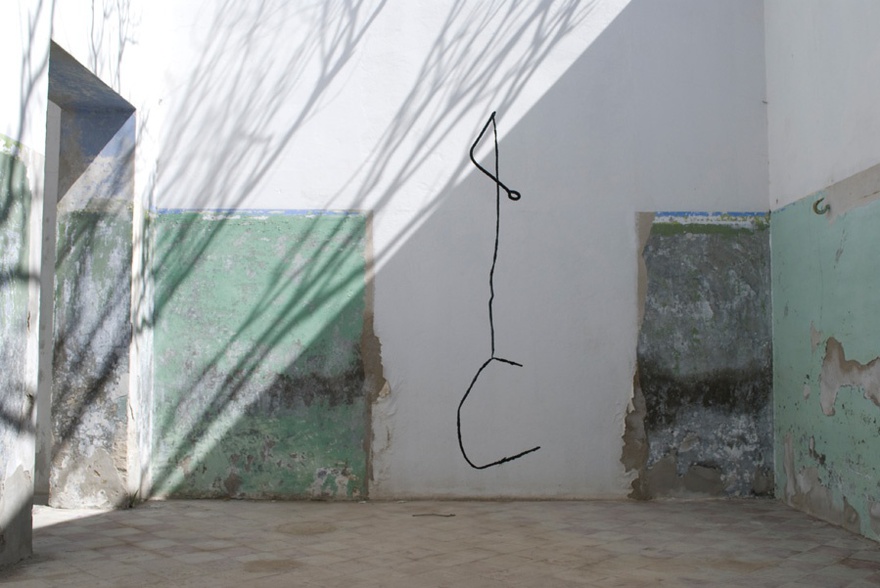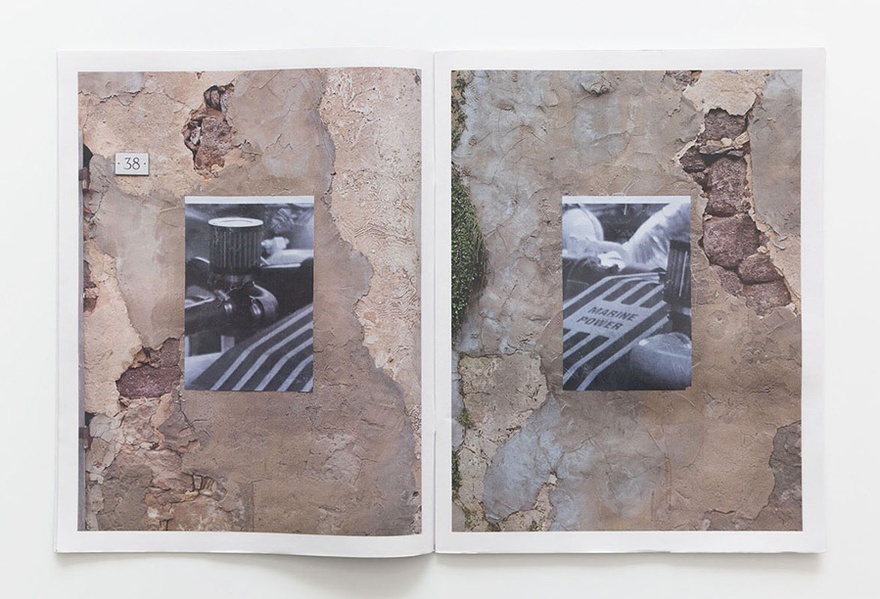Interviews
When Energy Becomes Form
Stefano Rabolli Pansera in conversation with Stephanie Bailey
Operating out of Europe since 2009, and the Mediterranean and Africa since 2012, Beyond Entropy is an independent collaborative practice that operates globally in association with public organizations, private institutions and governmental agencies. Originally developed by Stefano Rabolli Pansera as a trans-disciplinary research platform at the Architectural Association in London, Beyond Entropy engages in a variety of projects, from curatorial activities to art installations, architectural interventions to master plans, and public debates to publications. These endeavours are all driven by a notion of energy as 'a conceptual device used to conceive new architectural strategies that reveal space not as a fixed, measurable entity but as a temporal coalescence of continuously unfolding forces.' Research is articulated around four concepts: entropy, form, energy, and space, and the project operates at the intersections of art, architecture and geopolitics. In this interview, Beyond Entropy founder Stefano Rabolli Pansera contemplates – and problematizes – the themes of Platform 008.
Stephanie Bailey: In terms of the parameters Beyond Entropy sets for its projects, which occur in different parts of the world and in different forms, how do you establish links with the sites you engage with and how do you identify the approaches you will take in each place?
Stefano Rabolli Pansera: This question is interesting because it alludes to the separation between the parameter, which is the method we use and the site that we engage with. However, this is not really a distinction because the site we are in is precisely a result of the method we employ. We have to ask the question: What is the Mediterranean? The Mediterranean is a territory that is defined by this bipolar fracture between uses, forms of occupation and so on. This site does not necessarily correspond strictly to the Mediterranean coastline – the recurring territorial problem exceeds the geographical definition. Therefore, the parameter or method we choose is the site that we define and construct. I strongly believe that the site is not a given or a found element; it is not a ready-made but the result of a project, the result of a method of analysis. Of course, there is a constant circularity between the method, which needs to be relevant for the physical geographical site and the site that needs to match the method that we have employed. Our site selection follows the setting-up or construction of a theoretical model and everything that fits is absorbed or digested through this lens or model and can become our site and therefore comes to existence.
SB: In this light, what was your immediate response to the main question of Platform 008 in terms of how it reflects on Beyond Entropy's own approach towards certain cultural and regional cartographies?
SRP: My immediate response was two-fold: on the one hand, my interest derives from my perspective on art as a privileged platform used to understand cultural and physical territories. On the other hand, I am concerned with the fact that I am not an expert on MENA-related issues. I have worked in Beirut for Beyond Entropy Mediterranean, and in Angola, for Beyond Entropy Africa, but I have never developed a research in the MENA region and I don't think that the research of Beyond Entropy Africa and Beyond Entropy Mediterranean can be directly assimilated to what you are describing.
SB: Why? Platform 008 explores the relationships within the wider Global South, which includes nations like Lebanon, and indeed regions like Africa.
SRP: When Beyond Entropy works on a specific territory, it defines an entity that is not within a 'given' geographical area, such as the Global South, Latin America, MENA, but a region that is composed of areas that share a similar spatial condition. A territory is not really related to a purely geographical entity but is the result of a conceptual analysis. This is the reason why, from a geographical point of view, some of the territories Beyond Entropy engages in overlap or, in some cases, connect territories that are distant from each other. For example, Beyond Entropy Africa focuses on the cities in Sub-Saharan Africa only, while Beyond Entropy Mediterranean focuses on the Mediterranean coastline by analysing the North African and European coastline together.
SB: Could you talk about the project that emerged from your analysis of the Mediterranean coastline, the Mangiabarche Open Air Gallery?
SRP: The Mangiabarche Gallery is an open-air gallery on the tiny island of Sant-Antioco off south-west Sardinia that hosts a wide-ranging residency programme that maintains openness from a spatial and curatorial perspective. The project has a paradigmatic value in the sense that it is not seen as an individual project but as case study: a collaboration with the Coastal Conservation Agency of Sardinia, and the Calasetta Museum of Contemporary Art, located nearby in the small village in the south west of Sardinia. Calasetta is interesting because within a radius of 20 kilometres, it is possible to encounter all the territorial conflicts of the Mediterranean: a large abandoned factory (Alcoa), a natural park, an original fisherman village from the seventeenth century and newly built touristic villages that are overcrowded in the summer and deserted at winter time. Our proposal was 'to change everything by changing nothing': we took an existing military barrack that was abandoned on the coast and by removing the roof created an open-air gallery.
SB: When and how was the project inaugurated?
SRP: The gallery was inaugurated in November 2012 with Variable Length – an installation by Beyond Entropy and a live performance by Vincenzo Favata. The title echoed the mandate of the architectural intervention executed on the existing structure in Mangiabarche and the ethos of Beyond Entropy. The installation was composed of fuses and ropes creating a measuring system that allowed its elements to act as architectural tools for representing the space. By igniting the fuses and burning the rope, the system measured the minimum dimensions required to create the space of the gallery.
Since then, the gallery has invited a number of artists to confront the context – the Sardinian coast and a gallery space exposed to time and the elements – and investigate the use of architectural space within their practice by contributing to the infrastructure of the gallery and responding to the already existent forms and conditions. By adding a mirror, Marco Lampis expanded the boundary of the gallery space beyond its physical limitations. Inspired by the travel diary of Bruno Rombi, a Venetian writer who resided in Calasetta in the middle of the twentieth century, Davide Battistin placed in the middle of the gallery space a guzzetta, a small boat that is used traditionally in the area. Nicolas Amato, by suspending a thick system of branches created a spectacle of shadows on the naked walls of the gallery, choosing the title Cucoloris (2013) for the project: a technical term used within the film industry to refer to artificial devices capable of creating movement through shadows. Robert Pratt, on the other hand, used scrap metal found in the town and, in addition to painting it black, suspended it in perfect balance and left it to the sway of the strong wind of the Sardinian coast. Steve Bishop's 68 prints of a detail of a motor boat entitled Focus II (2013) amplified the importance of the exhibition space. Through the artists' intervention of hanging the prints through the streets of Calasetta, the space was no longer intended as a transformable neutral element but as substance and matter that have an impact on the work itself. The photographic documentation of this public process revealed the urban fragments transforming the town into an extension of the gallery.
SB: What conceptual analysis of the Mediterranean coast informed the project?
SRP: The gallery is an epicentre for the entire Mediterranean territory as we define it, and we conceived of it out of a 2004 bill Renato Soru passed in Sardinia called the Legge Salvacoste (coast-saving), which forbids anyone from building anything within three kilometres of the coastline. This was the legal parameter we took into consideration in order to define what the Mediterranean territory is. So what we did was to virtually extend this law to the entire Mediterranean coastline and imagined the coastline as being the area that is three kilometres from the coast. Upon looking at this very specific territory, we realized that there are incredible contradictions; we define it as a bipolar region. Everything in the Mediterranean passes from one opposite to the other: it is one of the regions with the largest national parks that are protected and are off-limits to visitors and, at the same time, it is punctuated by thousands of tourist developments that destroy the coastline. On the one hand, it is very often an underdeveloped region, quite poor and with low industrial production but on the other hand, some of the largest infrastructures in Europe are located within the Mediterranean region and heavily affect the coastline that we are considering. It is a territory that is mostly empty, if we exclude some major cities on the coast; nevertheless it becomes over-crowded in the summer months of July and August. There is a bipolar occupation of the coastline.
SB: Vera Sacchetti, writing for Domus, called the project a kind of Mediterranean Kunsthalle, in that it is 'connected under the umbrella of the recently created Fondazione MACC, and seek to bring contemporary art – through artist residencies, installations and exhibitions – to this corner of the Mediterranean,' and also seeks to 'envision a future for this geopolitical territory beyond the current dialectic.' What commonalities and differences have you observed in this project, which has essentially mapped out a kind of relation through the Mediterranean coastline?
SRP: In this case, the commonality and the differences that we have observed are not so much in the quality or the type of spatial problems that we have encountered but it was in the density, the repetition and the recurrence of this spatial situation. We produced a map of the 1,037 museums that are found in this three kilometre span from the coastline of the Mediterranean. On the map, we removed the outline of the continent and the separation between land and sea – what we were left with was this beautiful constellation that is very dense and very well defined in the north of Europe and begins to lessen in countries such as Croatia and Greece. There are a few very dense points around Istanbul, Tel Aviv, Beirut and Cairo while the rest of the north of Africa is basically empty. I find this very interesting because I believe there is no difference in the type of problem but there is great diversity in the degree of intensity in this scenario of exploitation. There is no difference in the quality or type of problem but a difference in the recurrence of it.
SB: This of course relates to the first question in the remit: how do we effectively map the historical and contemporary relationships that exist between North Africa, the Middle East and the Global South?
SRP: The very concept of the Global South is contemporary. I do not believe that the Global South existed before the globalized world. In the past, there were colonial empires and colonized regions, but there is a clear difference between those colonized regions and the Global South. Before the colonial period, when unknown lands became known, there were mysterious and exotic territories that were yet to be discovered, famously labelled on ancient maps by the words 'Hic sunt dracones' – 'Here be dragons'. However, today we cannot assimilate the Global South into an exotic, fantastic region. Thus, in order to answer the question, firstly, we must establish what you mean by Global South: what is its contour, how do we define it? Secondly, we need to establish if there is a relationship between the MENA and the Global South. Is the MENA part of the Global South or is it an independent region between the Global North and the Global South?
SB: And this relates to the question of how Platform 008 is locating the MENA within the context of the Global South.
SRP: In order to locate the MENA within the Global South, we must define the contours of the Global South. In the globalized world, the location of every point is ever-changing in a kaleidoscopic array of relationships. In a globalized world, topography morphs into a topology in the sense that the topographic definition of a position on the surface of the earth (based on fixed, quantifiable presences) is vaporizing in favour of the properties of space that are preserved under continuous deformations. Every location is replaced by a set of ever changing relationships. Therefore, countries that are geographically (and traditionally) part of the Global North (Portugal for example) are drifting 'South' while countries (Angola for example) that are geographically in the South are effectively part of the 'North'. According to specific cultural parameters some of the MENA countries (Qatar) are more northern than 'North'!
Nevertheless, I believe that the MENA region is an interesting point to analyse the ever-changing drift between the Global North and the Global South. In this respect, I consider the MENA region as a point of singularity. In mathematics a point of singularity is a point where a progressive quantitative change produces a qualitative transformation: for example, zero degree of temperature is a point of singularity because the progressive reduction of temperature at zero degree changes the status of the water from liquid to solid. In the same way, I can refer to Deleuze, to say that the MENA region can be the point of singularity where we can analyse the becoming-'South' of the 'North' and the becoming-'North' of the 'South'.
SB: Are there inherent tensions within the concept of the Global South?
SRP: Of course, there are inherent tensions in every context. There are constant dynamics within every part of the city. When the African governments destroy large parts of local traditional peri-urban areas (like the Angolan 'musseq') in order to build Chinese-like blocks, we are witnessing one of these moments of tension within the Global South. In the same way, when we are witnessing unexpected and unpredictable urban transformations that exceed the central planning of the government in European suburbs or in Chinese developments, we are assisting to the inner tension within the Global North. The inner tension is vital for every context to exist as such.
SB: Which questions in the remit do you find most pertinent and why?
SRP: I liked the questions that allude to the idea that territories are the result of specific investigation and not a given geographical fact. Each territory emerges from a specific analysis and from a specific project. A territory is always the result of the map.
SB: I'd love for you to develop this in relation to the work Beyond Entropy has done, and its approach as a whole. Beyond Entropy states that its purpose is to operate globally in situations of territorial crisis – but how would you define a 'territory' and how has this definition changed in accordance to the regions – and projects – you have engaged with?
SRP: The territory of Beyond Entropy is the result of a process of analysis and re-configurations of spatial relations. In this respect, there is an interesting conceptual loop where the 'geographical' territory is both the condition of possibility of the analysis and, in some newly configured form, its necessary outcome. In other words, every region is an entity analysed according to a specific spatial crisis that defines the territory itself. For 'spatial crisis' I mean a specific urban or spatial condition that refuses any pre-existing categorization: it is a spatial condition that requires the invention of new architectural models and new spatial practice to be fully understood. The urban sprawl in the European territory, the unfinished suburbs (ruins and working sites) in the Balkans, the African metropolis without infrastructures and the bipolar occupation of the Mediterranean coastline are examples of spatial crisis. It is not necessarily a negative situation; it is simply a spatial condition that the architectural and planning discourse haven't fully understood yet.
SB: And here, I suppose it would be good to discuss the distinction you make by using the work 'map' as opposed to cartographies…
SRP: Cartographies (and maps) are representations that instrumentalize the territory. Having said that, I believe that the term cartography is not correct because it implies that we are dealing with positions; geographical, political, cultural and social entities that are fixed and quantifiable. On the contrary, as I have explained before, we could just talk about the relationship between a position in a given set and about continuities or discontinuities in a continuum.
SB: This relates to projects you have done in Africa and namely Luanda. I understand you view this site, as you did with Calasetta, as a paradigm: in the case of Calasetta, this is the complexities of the Mediterranean's contested geography. With Luanda, you have observed a city with a complexity that derives from unpredictable spaces and irreconcilable programmes. How did you come to select Luanda as a site?
SRP: Beyond Entropy Africa, co-directed with Paula Nascimento, focuses on Luanda, the capital of Angola as the paradigm of the extraordinary urban transformations that are taking place in Africa. Luanda is a huge city (approximately eight million people) composed of several areas without basic infrastructures. Furthermore, some of the 'musseq' are composed of buildings that are one or two storeys high while the urban density is higher than Manhattan's. To understand this condition, we defined the concept of 'morphing space' as the constant 'becoming-other' of each space in Luanda. All the projects we have developed thus far, the energetic common ground (Biennale of Architecture in 2012) and the photographic project of Edson Chagas, Luanda Encyclopaedic City, for the Art Biennale in 2013, respond to this specific use of space.
SB: On Luanda, Encyclopaedic City the project, Beyond Entropy stated: 'no building can contain a universal multiplicity of spaces, possibilities, and conditions. When a building tends towards the encyclopaedic, it becomes a city,' just as a city might become an encyclopaedia. Does this relate to the kind of mapping Beyond Entropy engages with?
SRP: Not directly. The pavilion answered to the specific brief of the Biennial of Massimiliano Gioni, Encyclopedic Palace, and showed a specific type of African use of the space. Of course, the decision to invite Edson Chagas is derived from Beyond Entropy's analysis of the 'morphing' space. In fact, Edson's photography shows how derelict objects are de-territorialized in the urban space and, by creating a new set of relations with the context, have the power to re-territorialize the city.
SB: You also organized, as part of the 55th Venice Biennale, the 'Bilateral Meeting' during the opening of the Angola pavilion – the first bilateral meeting between the Minister of Culture of Angola, H.E Mrs Rosa Cruz e Silva, and the Minister of Culture of Italy, Mr. Massimo Bray. It is stated that: 'The meeting articulate[d] the large collaboration of two countries, which was triggered by the first participation of Angola.' This relates to how art might produce new networks that are not only cultural, but also political. This in turn affects dynamics and relations within the global space. Is this something Beyond Entropy is concerned with?
SRP: Of course, as a spatial practice, Beyond Entropy is dealing with art and architecture as much as with geo-politics. We cannot be naïve to assume that our discourse does not have a geo-political relevance.
SB: And in terms of the geo-political approach, what are the aims of Beyond Entropy?
SRP: I don't think we have geopolitical aims; our aim is to understand architecture trough transformation and qualitative becoming that we call 'energy'. We realize that there is not one unique answer to this problem but that there are several degrees of declination of the same question in different parts of the globe. Therefore, it is not really about comparing or creating some sort of uniformity between these different territories but it is about enhancing, showing and making sense of the differences that are present in these several parts. This has a geopolitical effect. We are not interested in formulating political projects for their own sake but we believe that it is inevitable that the spatial discourse we are pursuing needs to engage with this level of conversation. When we talk about large scale interventions or when we consider an entire region such as the Mediterranean, by nature, we are dealing with something that exceeds the conventional scales of architecture and town planning and enters into a larger territorial realm. The natural interlocutors of these discourses are governments, political institutions – this is the reason why we work closely with this geopolitical investigation. I wouldn't say, however, that we have a geopolitical aim; in a way, geopolitics is a suitable domain for the scale of our research.
SB: In light of this, to your mind are there counter-hegemonic networks that exist but that are no longer peripheral, which is another Platform 008 remit question?
SRP: Do you mean peripheral in relation to a 'centre' that does not exist anymore? Counter-hegemonic networks are the very centre of the networks of culture and communication. They are viral approaches that resist any form of gentrification. Any artist that subverts the codes of communication, every architectural practice that reveals a new, unprecedented way to dwell the space, any political and social activity (not necessarily activist in nature) that opens a new model of being together with people, is counter-hegemonic. And this type of liberating, creative act happens in the very centre of the hegemonic norm.
SB: Does the periphery still exist?
SRP: The periphery still exists and it is everywhere. Far from being isolated in the geographical south, we find the Global South in every city, in every suburb, in every capital.
SB: Do multiple centres exist?
SRP: Multiple centres exist and they are points of singularity where 'North' and 'South' meet and collide. For example, in the very direct, geographical way, I recall an interesting example of a city that is a multiple centre. I recently travelled within several African cities and every time I travelled, I had my flight connection in Dubai, and I was amazed because Dubai is probably the most important African hub even if it is not physically located in Africa.
SB: You have said that, as far as you know, art and science are the only fields that are led by a true sense of imagination but you don't know if artists have managed to overtake divided, national, territorial or regional networks in favour of a globalized form of making. You just see a constant attempt to invent a new language that challenges the pre-defined conventions of what art should be and that produces new aesthetics. Could you expand on this further? What kind of globalized form of making do you have in mind? And where does architecture and research architecture fit into this? Do you think art and architecture have differing trajectories in this regard?
SRP: Architecture is always late in this type of process. What I am referring to are some artistic practices that are focused not on producing artworks as such (a topographic idea of object) but in subverting the relationship between the objects in a new ensemble.
I am thinking of the work of William Leavitt: by articulating few architectural elements he is capable of constituting a world. This is an interesting example of a new form of making a territory. William Leavitt shows how to create a territory by de-territorializing objects in order to re-territorialize them again in a new ensemble.
SB: Further to that, what about the infrastructures of the art world – biennales, for instance: from your experience working within this frame, how might they affect an emerging globalism in which regions are no longer defined on separate terms, but are instead read as a singular space in which difference is mediated and defined?
SRP: This is in a way inevitable because today, the real issue is that there is no real difference as the market is the same everywhere. The ecumenism of the church has been materialized; however, it has been materialized in the form of a continuous market. The main force of globalization is the market and biennales reflect this approach. Today, you can go to São Paulo, Gwangju or any other biennale and you discover the same artists, the same research and the same discourse. This is why I very much enjoy the challenge of the biennale because while it maintains its apparently old-fashioned division of the national pavilions it still invites you to discover some sort of fracture or inconsistency in the even-covering surface of the earth that is the market. This is exactly what we tried to do with the Angola Pavilions and the Albania Pavilion – thanks to the institutional framework of the Venice Biennale we tried to discover a very specific topic that is relevant in these territories that exceeds the definition of the market and its requirements.
SB: This relates to how you answered one of the remit questions – how can we rethink Occidental/Oriental paradigms. You said: 'We should not rethink the paradigm of 'East' and 'West' but we should start learning how to manoeuvre and navigate in the abyss that exists between them and where we are always located.' From your vantage point, what is this abyss, and how do we locate ourselves within it today?
SRP: Whereas others are interested in creating bridges between cultures, we theorize abysses and incommensurable distances. Beyond Entropy focuses on establishing the irreducible difference of each territory: we are not interested in proposing a uniform solution.
Stefano Rabolli Pansera is an Italian architect, architectural theorist, urbanist, and curator. Rabolli Pansera studied at the Architectural Association School of Architecture in London where he graduated with honours in 2005. He is the founding director of Beyond Entropy Ltd. In 2013, Stefano Raboli Pansera won the Golden Lion at 55th International Art Exhibition – La biennale di Venezia for having co-curated the Angola Pavilion with Paula Nascimento.
Beyond Entropy is a not-for-profit limited company registered in the United Kingdom. Beyond Entropy was originally developed by Stefano Rabolli Pansera in 2009 as a trans-disciplinary research platform at the Architectural Association, School of Architecture, in London. Beyond Entropy Ltd is now an independent collaborative practice operating globally in association with public organizations, private institutions and governmental agencies. Beyond Entropy Ltd operates at the threshold between art, architecture and geopolitics while developing a variety of projects: from curatorial activities to art installations, from architectural interventions to master-plans, from public debates to publications. Beyond Entropy Ltd operates as a holding company, owning shares in each affiliated company, which is directed by a local partner. Beyond Entropy Africa, registered in Angola in 2012, is directed by Paula Nascimento.

